Water Landscapes
The phenomenon of Thermalism in the Euganean District between Antiquity and the Modern Age
The Euganean territory is located in a unique geographical position, rising as an autonomous and isolated hilly complex in the heart of the Po Valley and bordered, in ancient times, by two of the great Venetian rivers: Adige and Bacchiglione. Due to its peculiar geo-topographical and climatic characteristics, it has always been of interest to humans, witnessing continuous settlements since prehistoric times. Its abundant resources, such as stone, water, timber, cultivable land, and pastures, made it one of the most popular places, especially during the most significant historical phases from the Iron Age to the Roman period, and this interest continued consistently throughout subsequent periods, from the Middle Ages to modern times (Selmin 2005). Particularly during the Roman occupation, which superseded the rich civilization of the ancient Veneti in the management of the territory, the two hilly slopes were officially divided between the main urban centers – Venetian first and now Roman –, of Ateste and Patavium. This intervention, prompted by a dispute between the two cities, took place in 141 B.C., marked by the placement of boundary stones that unequivocally defined the areas of jurisdiction for each settlement. The conflict of interests must have arisen from the abundant resources of the hilly territory, from which urban communities derived profits and development opportunities (Zanovello 2005, 104-108).

1 | Thermal manifestations in the Euganean Hills (elaborated from Google Maps by A. Meleri).
2 | The geothermal phenomenon in the Euganean area (from Fabbri 2023).
One of these resources was undoubtedly the thermal one, a phenomenon of ancient volcanic origin and widespread in the Euganean territory [Fig. 1]: an area where waters emerged from the pre-Alpine arc. After a long journey at great depths, these waters were pushed to the surface with very high temperatures and a peculiar richness of chemical and physical components with healing properties (Fabbri 2011) [Fig. 2]. In the ancient world, the thermal phenomenon was perceived as directly connected to divine entities, through whose intervention or mediation, humans could obtain healing, health, and well-being (Annibaletto, Bassani, Ghedini 2014).
The Northeastern Slope and the Patavini Fontes or Aquae Patavinae
The Euganean area was known in Latin literary sources, which in Roman times associated it with the god Aponus, whose name, according to some, meant “without pain” (a-ponos), while according to others, it referred to the essence of water itself (from the Indo-European root ap- which indicates flowing water). In the Aponense area, known in antiquity as Aquae Patavinae and today as Terme Euganee, the Romans established a renowned resort and healing station on the site of an ancient protohistoric sanctuary, equally famous as other important thermal areas, such as Baia in the Campania region, a typical example of the ancient authors’ perception and exploitation of thermalism, which they referred to as “otium baianum”: a place of well-being, vacation, and relaxation, away from the rules and obligations of daily life (Zanovello 2011).
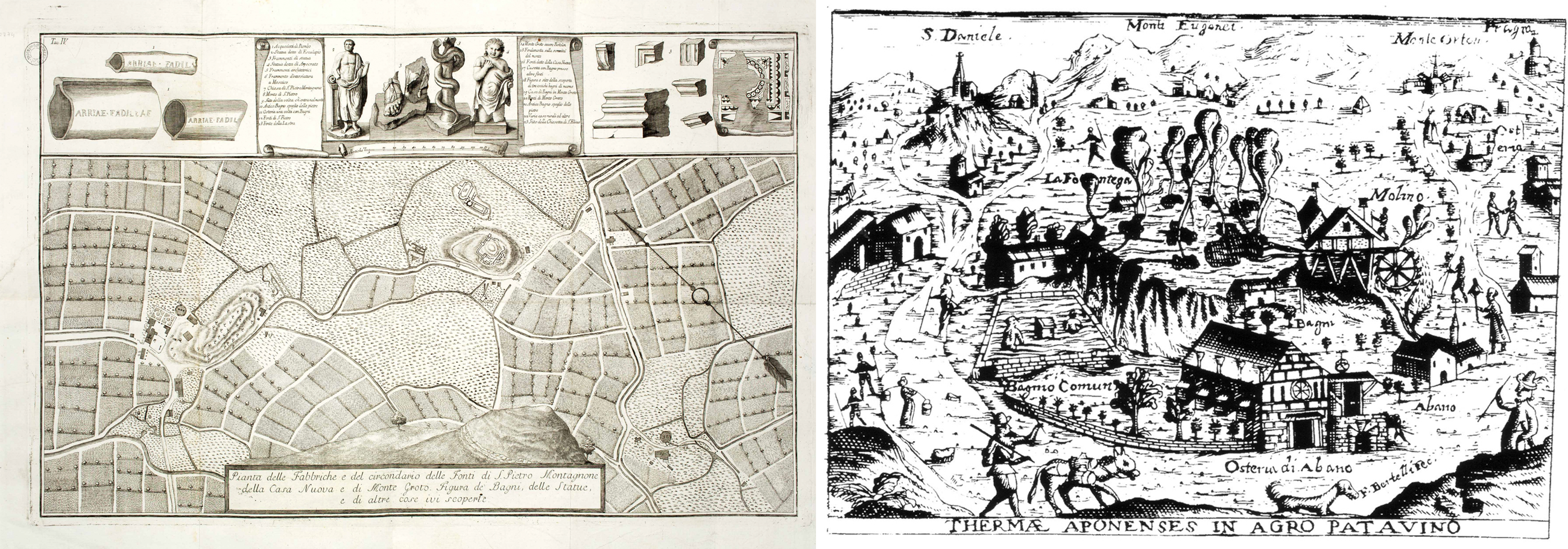
3 | The area of Aquae Patavinae in the fourth plate of Salvatore Mandruzzato (1804).
4 | Thermal facilities in Abano in an engraving by Francesco Bertelli (early 17th century).
In the territory of present-day Montegrotto Terme, where the lake sacred to Aponus was also located, a considerable number of structures dedicated to the exploitation of thermalism and accommodation of visitors were concentrated: pools, basins, and hydraulic systems were distributed in the area, and were almost certainly related to the thermal springs that naturally gushed up to the surface at that time [Fig. 3]. Grandiose houses and villas, perhaps even imperial properties, were built in the immediate vicinity. The materials recovered during various excavation activities, carried out from the late 18th century until today, bear witness both to a widespread frequentation and a display of luxury and wealth by the owners and the visitors themselves (Aquae Patavinae 2011; 2012; Aquae Salutiferae 2013).
In the neighboring territory of present-day Abano, which derives its name from the ancient Latin deity, archaeological documentation shows a predominantly rural occupation, although there are also cultic testimonies related to the thermal phenomenon: here the healing waters only naturally gushed to the surface in the area of Montirone, but they were widely present underground and thus accessible through pumping. This is evidenced by the continuity of life in curative and hospitality structures between the Middle Ages and the modern and contemporary eras. During this period, the area of Abano, especially under the rule of Venice, became much more important and frequented compared to Montegrotto (Grandis 2005, 217-221; Zanovello 2012; Bressan, Bonini 2012). Rich iconographic documentation [Fig. 4] and descriptions testify to the fame of the place and its frequentation by various social classes: free medical treatments for the less affluent, who could freely access the basins filled with beneficial water, but also a place of well-being and leisure, especially for Venetian and Paduan nobles who often built their luxurious summer residences in the area (Rippa Bonati 2013; Dal Pozzolo 2013).
It should also be noted that until the First World War, a significant portion of the thermal area in the eastern sector of the Euganean Hills was administered as a single entity: 1918 saw the separation of S.Pietro Montagnon, present-day Montegrotto, from the Municipality of Battaglia, while the territory of Abano remained dependent on Padua and known as Abano Bagni until 1924.
The Southeastern Slope
Euganean thermalism is not however limited solely to the Aponense area: water sources with similar characteristics are also found in the nearby broad valley, now occupied by the modern thermal centers of Galzignano and Battaglia. Other thermal phenomena are recorded in the Monselice area with “laghetto di Lispida” (Lispida pond), and in the nearby Arquà Petrarca with “laghetto della Costa” (Costa pond), also known for having been the site of a Bronze Age pile-dwelling village (Bianchin Citton, Zerbinati 1994).
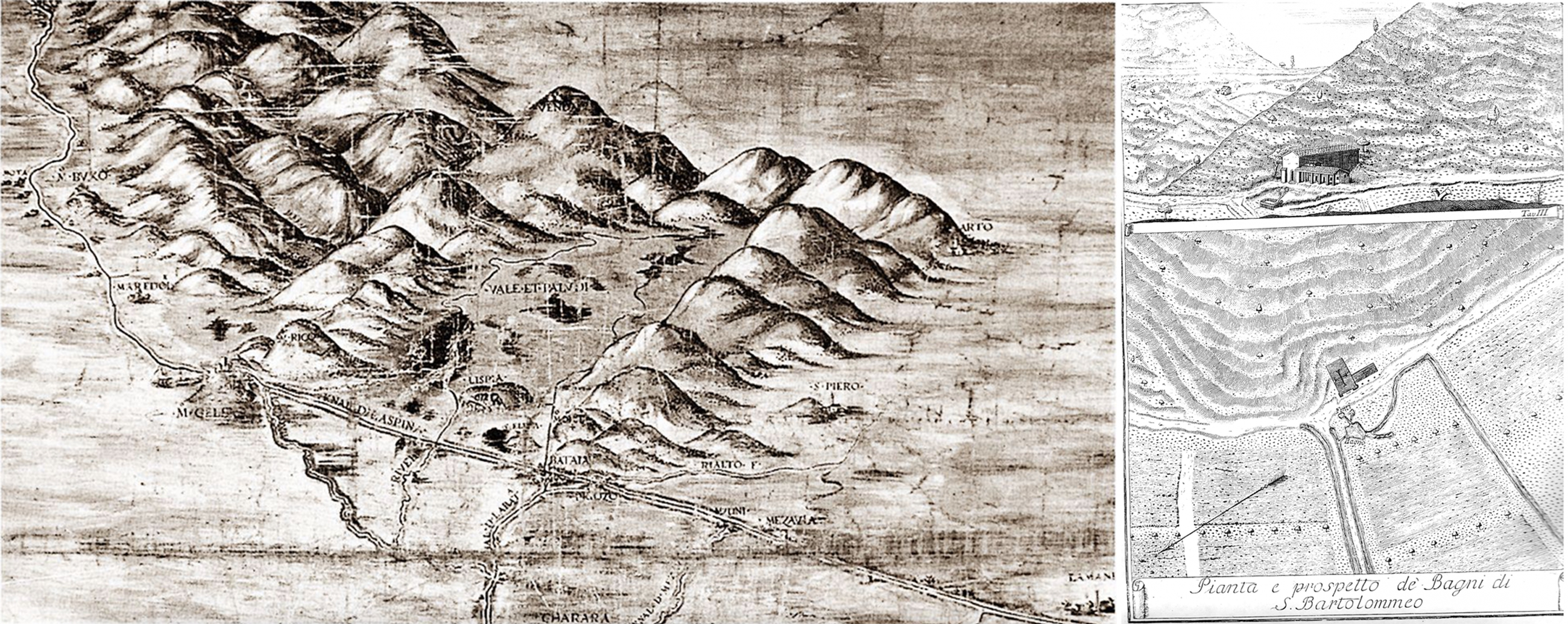
5 | A detail from the large map of the Paduan territory, drawn by Nicolò dal Cortivo in 1534, showing the valleys and swamps in the area between Galzignano, Battaglia, Lispida, and Monselice. On the left of Battaglia, the hill of S.Elena owned by the Selvatico family is visible.
6 | The thermal area of S.Bartolomeo in the third plate of Salvatore Mandruzzato (1804).
Today many of these areas are unfortunately hardly recognizable. The entire plain between Battaglia (with its “hanging canal” built between 1189 and 1201), Monselice, and Este underwent careful marsh reclamation by Venice around the mid-16th century. As in some 16th century maps, the plain surrounding the southeastern sector of the Euganean Hills was a vast swamp fed by various springs, including thermal ones, mainly because of poor regulation of river waters [Fig. 5]. Following economic difficulties caused by the war ended with the Treaty of Cambrai, a new magistracy called “Provveditori sopra i Beni Inculti” (magistrates of uncultivated properties) was created in 1556, with the objective of restoring lands that were unproductive due to water stagnation. The following year, the project known as “Retratto di Monselice” was initiated, envisioning the “retratto” (reclamation) of lands comprised “from Battaglia to Este, bordering the river or Moncelese canal, and the surrounding hills around the valleys of Galzignano, Valsanzibio, Arquà, and Baon” (Archivio di Stato di Padova (ASP), Certosa di Padova, b. 16, fasc. 6, proclamation in print dated August 6, 1557; Grandis 2005; Grandis 2016). The project involved direct financing by the landowners, who were not always in a position to undertake financial commitments. Among those who participated in the project were Bartolomeo Selvatico, with a portion of land in the Lispida area, Antonio Saviolo in the Regazzoni area in Galzignano, near the Bagni di S.Bartolomeo, and Giovanni and Andrea Placca coming from contrada della Costa of Arquà.
The modern centers of Galzignano and Battaglia occupy the valley between two extensions of the Euganean hill district: Monte Gallo, Orbieso, Calbarina to the west, and Monte delle Valli, Cimisella, Ceva to the east. Also in this area springs emerged, the exploitation of which dates back, at least, to the medieval period, when they were mentioned with denominations linked to Christianity. This should not be surprising, since the healing qualities of water continued to be placed under divine protection through various saintly figures. Especially in the early Christian world, water was perceived as a means of salvation, and as a symbol of purification. Likewise, thermal water maintained its fundamental role as an instrument of healing and health (Scorrano 2020). For this reason, both spring and thermal waters are always associated with saintly figures. Just as the saints Peter and Eliseo were connected to Montegrotto (S.Pietro in the central area of Montegrotto, where the tradition of the pagan temple remained, and S.Eliseo in the area of the Neronian Baths), tradition recalls the sources of Saint Bartholomew in Galzignano (at the border with Montegrotto’s territory) or the grotto springs dedicated to S.Eliseo and S.Elena in Battaglia. Testimonies of these connections can be found primarily in the rich archival and bibliographical documentation from the medieval and modern eras. The caves of S.Elena are mentioned in documents dating back to the 12th century, while the thermal places linked to S.Bartolomeo are mentioned in writings from the 15th century and are also depicted graphically in the plates attached to Salvatore Mandruzzato’s monumental work Dei Bagni di Abano, published in three volumes between the late 18th century and the early 19th century.
At the sources of S.Bartolomeo, which Mandruzzato places “within the ancient borders of Montegrotto to the west”, the Aponian physician devoted only a few pages, along with a large illustration [Fig. 6] depicting both plan and elevation of the area (Mandruzzato 1804, 95-99, tav. III; 113-119). Two highlighted springs, depicted as small pools, are connected to a larger irregularly shaped basin, enclosed by a fence and linked to a series of canals, undoubtedly designed for draining the surrounding countryside. Directly opposite, across a road, there was a church, and, perpendicular to it, a ‘rustic house’ with a porch facing the road. According to the author, the springs were among the “most famous and tested in the Paduan Territory”. However, during Mandruzzato’s time, the church dedicated to S.Bartolomeo was in a state of abandonment. “If we believe Savonarola, the noble Paduan family of Leoni built the church long before his time and also constructed a hospital to accommodate the poor”; Mandruzzato reports, but he points out that this information is absent from the descriptions of Bartolomeo Montagnana, who operated, like Savonarola, in the first half of the 15th century. In the description of the Paduan physician Michele Savonarola, included in his work De Balneis et Thermis naturalibus omnibus Italiae, “a large pool not built with stones, like all the other Paduan Baths, with a muddy, greasy, blackish, and very soft bottom, in which the bathers must necessarily immerse themselves: so if they don’t support themselves on beams that cross that pit, sometimes they would sink to a dangerous depth” (Mandruzzato 1804, 98). Mandruzzato notes that the bath was now disused but returned to be used on the day commemorating the Saint. Additionally, he adds that both the church and the thermal area belonged to an Abbey of the Obizzi family, which at that time was in the hands of Marchese Tommaso, “a gentleman of recognized talent and genius, and from whom the Baths of S.Bartolomeo would obtain greater splendor than all the other Aponian baths if the situation did not present an insurmountable obstacle” (Mandruzzato 1804, 99).
The reputation of these baths in the 15th century was undeniable, as they became the destination of illustrious figures and attracted the scientific interest of physicians in subsequent centuries, due to the unique characteristics of both water and mud. However, in the mid-16th century, Gabriele Falloppio reported their state of neglect, the absence of a place to accommodate the sick, and even “the adulteration of the mud with filthy mixture” (Mandruzzato 1804, 97).
According to Galliano Migliolaro, a local Aponian artist and historian, the church, “of late Romanesque style […] with a single nave with frescoed walls and a facade flanked by two bell towers”, dates back to the 11th century. It underwent several renovations and was eventually transformed into a residential structure following the Royal Decree of July 7, 1866, no. 3036, which established the suppression of religious orders and corporations (Migliolaro 1956, 136; Italia Nostra 2021). The source of S.Bartolomeo, a reference in popular tradition for skin diseases, remained in use until the 1960s.
Today, only a small pool remains amidst the countryside, situated on private property and adjacent to a medieval building that has undergone extensive transformations. The cult's testimony to the saint is preserved in a 15th-century statue within a small wayside shrine built near the spring.
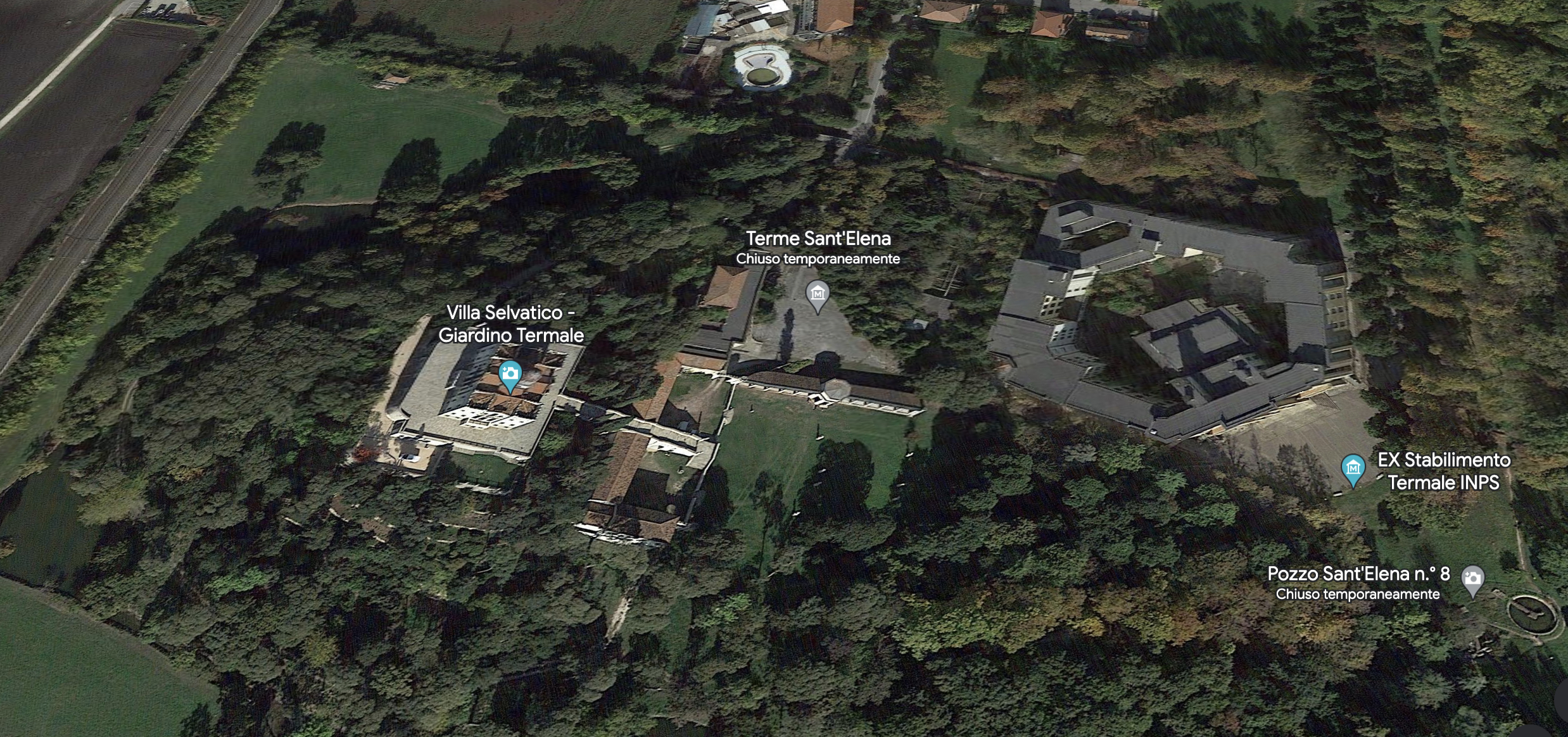
7 | The area of Villa Selvatico with the thermal park (Google Maps).
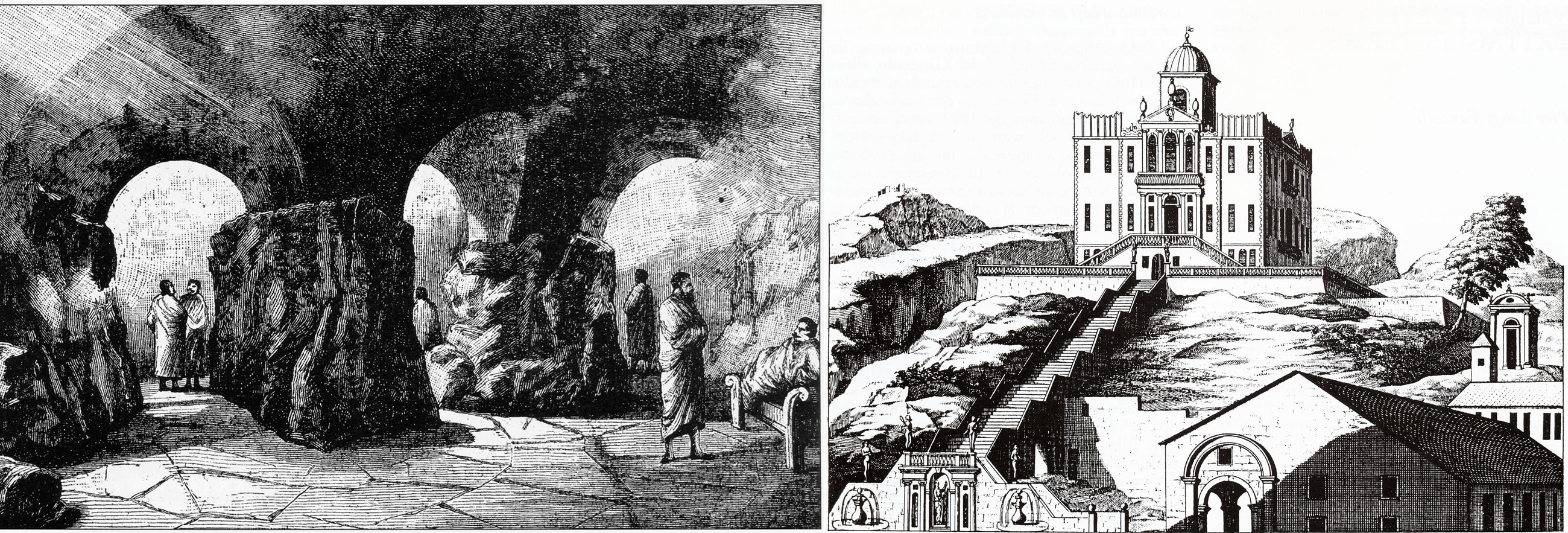
8 | The sudoriferous caves of the baths of S.Elena in an engraving from the late 19th century (https://battagliatermestoria.altervista.org/il-fango-termale-di-battaglia/).
9 | Villa Selvatico in an engraving by Montalegre (1714), with the chapel dedicated to S.Elena on the right (https://battagliatermestoria.altervista.org/villa-selvatico-a-battaglia-terme/).
In the neighboring Battaglia, several thermal lakes still exist, now part of the private property of Villa Selvatico, which only recently has been opened to the public [Fig. 7]. The earliest records of a settlement around the S.Elena hill date back to the 11th and 12th centuries. Ancient chronicles significantly refer to this hill as the ‘Monte della Stufa’ (Mount of the Stove) undoubtedly alluding to the presence of caves where steam baths were practiced (Mandruzzato 1804, 1-14, tav. I; 111-113; Menegazzi 1804) [Fig. 8]. The first thermal bath documented, around the mid-12th century, was dedicated to S.Eliseo, with an adjacent oratory in his honor, as in nearby Montegrotto. A few years later, a small church dedicated to the saint was built on the remains of the oratory, and alongside it S.Elena’s veneration. This specific worship became so increasingly significant that both the bath and the hill remained increasingly associated with the figure of S.Elena. In 1199, a noblewoman named Speronella Delesmanini, in a testament concerning a plot of land atop the hill, left a substantial sum of money to the Bishop of Padua to build a hospice for the poor and pilgrims near the thermal caves. In the Paduan Statutes of 1235, there is a record of an intervention carried out by the Municipality of Padua in this thermal area. Further mentions of this ‘hospice’ and the small church appear in subsequent centuries. In the first half of the 16th century, the hill came under the ownership of the Selvatico family, who already owned extensive estates between Galzignano, Battaglia, Lispida, and Arquà. Thereupon, a single large property extended over the southeastern sector of the Euganean Hills. At the summit of the S.Elena hill, the main house stood, surrounded by “fabricis ruinosis” (ruined buildings) and “balneis tectis et apertis” (covered and open baths). On November 13, 1580, Michel de Montaigne was recorded as being present here: he was seeking the thermal source used for the baths which in the same days saw the presence of Cardinal d’Este for the treatment of his gout (Pezzolo 1883; Cattani 1925, 35-52; Zanetti 1989).
In the early 17th century, the restructuring of the house atop the hill began; a project that spanned several decades and involved both local and external craftsmen for architectural, decorative, painting, and sculptural interventions. A veritable palace, with an already monumental external staircase as its focus element, was completed in the mid-17th century, and a new small church dedicated to S.Elena was built by the archdeacon Luigi Selvatico, to be used as the family chapel [Fig. 9].
Several interventions followed in the following centuries until the property, consisting of “two buildings for mineral baths, three rental houses, a holiday home with an orchard, a private oratory, and mineral springs” was sold in 1814 to Agostino Meneghini. He immediately commissioned Giuseppe Jappelli to reorganize and renovate both the villa and the large surrounding park, including the thermal lakes and bathing structures. Jappelli’s intervention is today still noticeable in the imposing structure of the villa, nestled in its splendid landscape. The property passed to the Von Wimpffen counts in 1842 and later to the Emo Capodilista family in the early 20th century (Fantelli 1989); several changes in ownership followed until the present day.
A different fate awaited a portion of the park and the hotel structure, which was also extensively renovated. In the 1930s, they were acquired by Cassa Nazionale delle Assicurazioni Sociali (National Social Insurance Fund), and in 1936, a new reception complex was built on the remains of the previous one, known as the ‘Terme dei Lavoratori’ (Worker’s Thermal Baths) or the ‘Stabilimento dell’Istituto Nazionale Fascista della Previdenza Sociale’ (Building of the National Fascist Social Security Institute, later INPS). This new establishment joined the existing hotels in the area: the Grand Hotel Terme, the Albergo S.Elena, and the Albergo Italia, all located along the Battaglia Canal, the main communication route with Padua and Venice. In the early 1960s, a new S.Elena Thermal Pavilion was constructed on the same site as the previous building, which was demolished.
The caves – or stoves – of St. Elena still exist today as are a regional property precluded from any intervention and public visit. The thermal waters are sourced from a great depth exclusively for the neighboring hotels and public baths between the towns of Battaglia and Galzignano.

10 | The territory of Lispida, with the area around Villa Italia and the thermal pond (Google Maps).
A little further to the west, in the territory of Monselice, near the small elevation of Monte Lispida and the thermal ponds of Battaglia, lies another thermal site, recognizable as a small body of water within a vast private property that also houses an important historical building known as the Castle of Lispida or Villa Italia [Fig. 10]. The first records of the site date back to the 13th century when a monastery of the Order of S.Augustine was established, along with a church dedicated to S.Maria di Ispida. During the rule of the Serenissima Republic of Venice, the property was confiscated by Doge Giovanni Mocenigo, and in the late 18th century it was acquired by the Corinaldi counts, who built the imposing villa that still stands today within an extensive vineyard estate (Callegari [1931] 1973, 59-60). In the estate, there is still a thermal lake with hot springs, used for the extraction of therapeutic mud that, after maturation, is employed in the nearby Euganean thermal area. This place, preserved in its natural and almost wild state, has given rise to a legend connected to the presence of a mermaid: Manfredo, Count of Monticelli, suffered from a painful leg ailment that led him to desire death. On the night of Saint John the Baptist, he approached the shores of the lake intending to end his sufferings when a beautiful girl, half-woman and half-fish, appeared before him with a melodious song, willing to help him. She descended into the depths of the lake, bringing him hot mud with which he was healed. In the following nights, he returned to the lake but never saw the girl again. According to tradition, on the night of Saint John, the spirits of the count and the maiden still meet, and those passing nearby might hear the enchanting song of the mermaid emanating from the lake’s depths (Rodella 1959, 97-109).

11-11a| Lago della Costa, now a UNESCO site, in the territory of Arquà Petrarca (Google Maps).
12 | The temple designed by G. Jappelli (reconstructed in 1938 by Adolfo Callegari) nearby the Raineriana Spring in the locality of Costa di Arquà Petrarca.
Not far away, towards the southwest in the territory of Arquà Petrarca, we find Lago della Costa (Callegari [1931] 1973, 279-280), recognized since 2011 as part of the UNESCO site ‘Prehistoric Pile dwellings around the Alps’ which houses a prehistoric pile dwelling village dating back to the Bronze Age (Bianchin Citton, Zerbinati 1994). Once again, it is a natural lake fed by a thermal spring, which was formerly exploited for mud extraction [Fig. 11].
Today, the area is difficult to access, enclosed within private property. Not far from there, in the same locality of Costa, another thermal spring can be found, known as Fonte Raineriana, named after Archduke Ranieri of Austria, who had a temple-like structure built there in 1829 [Fig. 12]. This neoclassical-style structure was also designed by Giuseppe Jappelli. Although it was demolished in 1932, it was later faithfully reconstructed based on a preserved drawing from the Jappelli iconographic collection at the Civic Library of Padua by Adolfo Callegari, the director of the Archaeological Museum of Atestino at that time. An inscription on the facade commemorates the archduke, who also funded studies on the sulfuric water of the spring to verify its therapeutic benefits (Callegari [1931] 1973, 280-283).
The western slope
The thermal phenomenon is also present on the western side of the Euganean Hills, particularly in the area of Val Calaona [Fig. 13], a large basin nestled between the Mounts Cero, Cinto, and Lozzo, known to have been inhabited since prehistoric times (Callegari [1931] 1973, 155).

13 | The sector of Val Calaona where the thermal springs are located, recently used for greenhouse cultivation (Google Maps).
14 | Advertisement poster from 1904 promoting the Terme della Val Calaona.
15 | Remains of the ancient thermal and accommodation structures in Val Calaona.
Gaetano Nuvolato, in his Storia di Este e del suo territorio, wrote about the thermal waters:
“Only two sources exist in our territory, those in the valley known as Calaona, and in lesser quantities at Fontanafredda. The former spring from peaty ground, with qualities similar to those of Abano, though slightly less hot, reaching a maximum temperature of 31 degrees Reaumur, equivalent to 38,75 degrees Celsius. Just over half a century ago, the baths began there, highly beneficial to the human body, and it is worth remembering a villager named Marin di Calaona, who was the first to introduce the use of baths in the area. Baths continue there during the summer, but due to the lack of a suitable establishment for the affluent classes, this sulfuric valley may have remained somewhat less renowned compared to the thermal baths of Abano and S.Elena, and other locations in the Euganean region. In our times, when public hygiene is so valued, one should take advantage of what provident nature offers, and either a company or the Municipality of Calaona, being the owner, should establish an establishment there which, close to the hills, could prove delightful and offer modern conveniences to both local and foreign visitors, leading to certain benefits for both that locality and the nearby city of Este” (Nuvolato [1851] 1969, 638-639).
The first documents mentioning the area date back to 1682, when it was freely accessible as part of Este territory. At that time, there were probably only pools and basins without any form of protection. It was only in the early 19th century, likely after an inspection by the Provincial Delegation of Padua, that some structures were built to enhance the enjoyment and reception of visitors, including a building and a common pool (Monselesan 1872). However, the management problem remained unresolved; documents from the second half of the 19th century, when the area fell under the jurisdiction of Baone, referred to the pool as an “infernal muddle” since “the water is never renewed, there are no changing rooms or separate rooms for men and women, and the stirring of the muddy bottom makes the appearance of the water repulsive.” In 1895, the provincial physician ordered its closure.
At the beginning of the 20th century, the Municipality of Baone launched a new project to exploit and promote the thermal phenomenon, both by constructing suitable bath and hotel facilities and through effective advertising campaigns [Fig. 14]. An article in the Paduan newspaper “La libertà” on July 10, 1904, reports: “we can assert that the Administration has spared no effort to make it a place of true moral and physical comfort.” Unfortunately, the events of World War I had their tragic consequences here too: the facilities were immediately used to house numerous refugees and quickly fell into a state of neglect within a few years; in 1921, the establishment was once again closed (Comune di Baone, Le terme di Val Calaona).
A new interest seemed to arise in the 1970s when scientific research was conducted on the waters and their qualities, but the economic commitment appeared too burdensome. The thermal pools continued to be freely frequented, but the thermal phenomenon was also exploited in another way: a Cooperative built greenhouses on an area of 11,500 m2 with permission from the Municipality of Baone, transforming the site into a productive zone for several years. The company later went bankrupt in 2013, and despite other attempts at recovery by the Municipality, the vast area remains in total decay [Fig. 15].
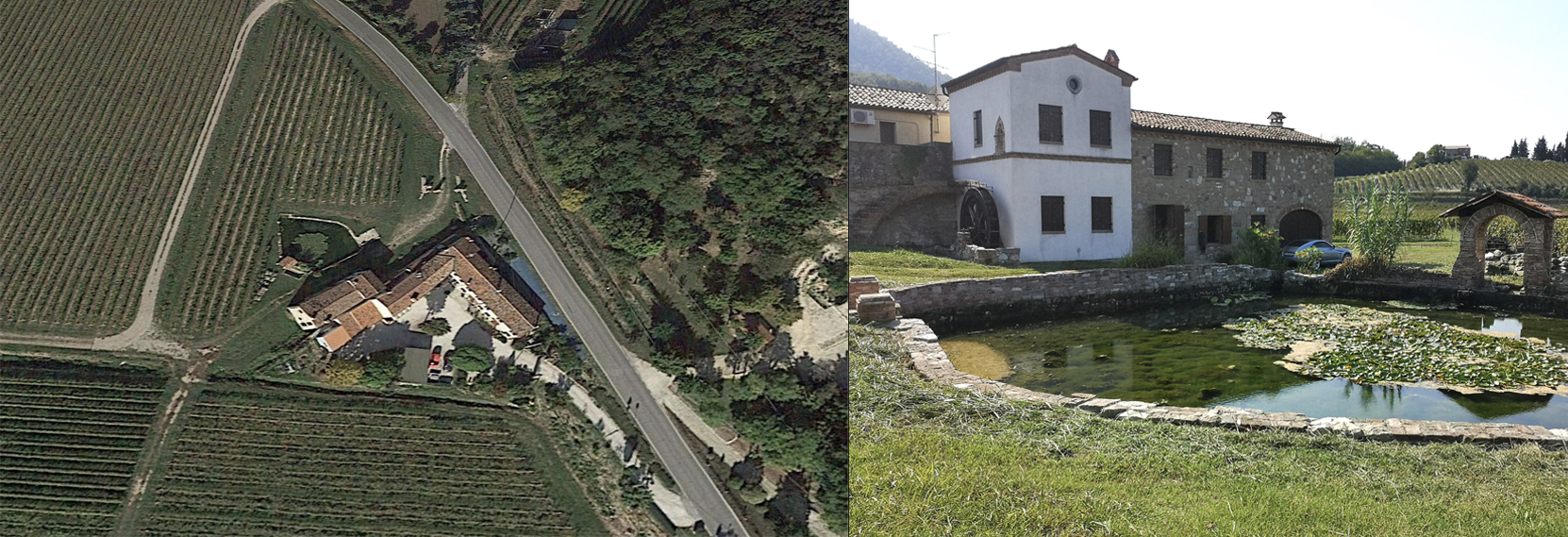
16 | Fontanafredda, locality Crosara with the thermal spring and the structures built over the years for productive activities (Google Maps).
17 | Crosara di Fontanafredda. The mill and the thermal tank after a recent restoration.
Not far away we find other thermal springs, such as the one mentioned by Nuvolato: in the locality of Crosara di Fontanafredda [Fig. 16], in the territory of Cinto Euganeo, a complex of tanks that collect water gushing at 27°C has been recently restored. According to local tradition, before the earthquake of 1976, the mildly sulfuric water reached a temperature of over 40°C and flowed from several points across the plain. Documented at least since the 12th century (Casarin 1976, 191, 313-314), its presence also favored productive activities: the Coppedello mill dates back to 1300 (Grandis 2001; Grandis 2005, 237-239), still preserved next to the main tank. The structure building was originally linked to flour production, while more recently the tank was used for macerating hemp, benefiting from the water’s temperature and chemical-physical composition [Fig. 17]. Today, a private intervention (Fontanafredda webpage) has led to the recovery and restoration of the structures, including the tanks, where the spontaneous gushing of water can still be witnessed on the surface. Despite some initiatives aimed at promoting its identity, few people are aware of the site, which, on the contrary, deserves proper enhancement for its historical and landscape significance.
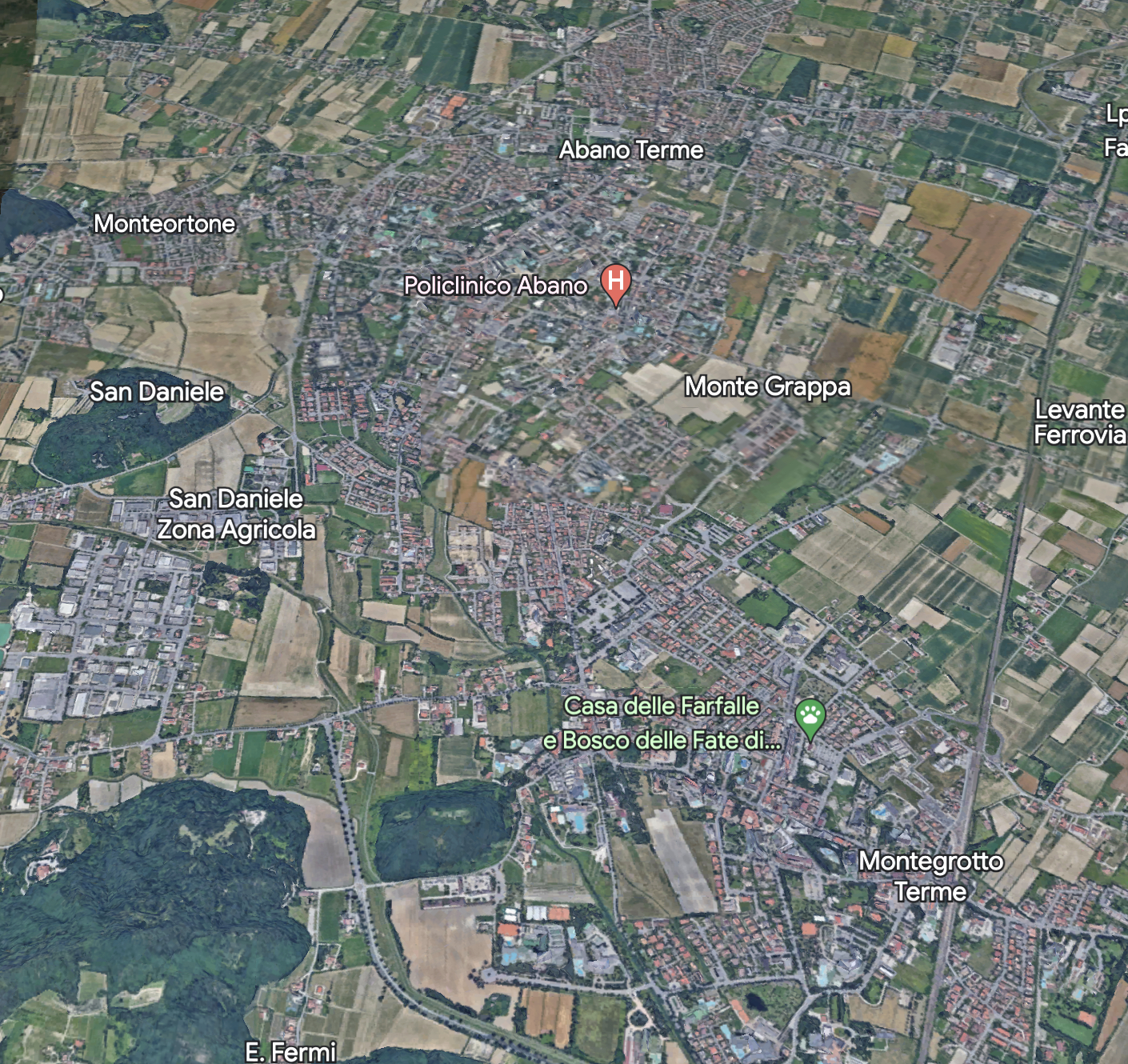
18 | The heavily urbanized territory between Montegrotto and Abano Terme (Google Maps).
The thermal phenomenon is thus very well present in the Euganean territory, although the fame and continuity of life of the Abano and Montegrotto areas have concentrated attention and interest primarily in their areas. The various historical events that these places have experienced have determined a development (or lack thereof) that has certainly influenced their evolution. From a historical-cultural perspective, it is noteworthy that in the less known and frequented places by international and local tourism, the thermal identity has remained more evident and perceivable, conserving its value and original appearance more faithfully. Today, thermalism still presents itself as a widespread and diverse water landscape, no longer visible in the territory of Montegrotto and Abano, where urbanization and extensive tourist visitation have radically transformed the landscape [Fig. 18]. For this reason, the “minor” sites, equally rich in history and culture, should be valorised in order to make current visitors to modern thermal centers more aware of a long historical and social past.
Bibliographical references
- Aquae Patavinae 2011
M. Bassani, M. Bressan, E.F. Ghedini (a cura di), Aquae Patavinae. Il termalismo antico nel comprensorio euganeo e in Italia, Atti del I Convegno Nazionale (Padova, 21-22 giugno 2010), Padova 2011. - Aquae Patavinae 2012
M. Bassani, M. Bressan, E.F. Ghedini (a cura di), Aquae Patavinae. Montegrotto Terme e il termalismo in Italia. Aggiornamenti e nuove prospettive di valorizzazione, Atti del II Convegno Nazionale (Padova, 14-15 giugno 2011), Padova 2012. - Aquae Salutiferae 2013
M. Bassani, M. Bressan, E.F. Ghedini (a cura di), Aquae salutiferae. Il termalismo fra antico e contemporaneo, Atti del Convegno Internazionale (Montegrotto Terme (PD), 6-8 settembre 2012), Padova 2013. - Annibaletto, Bassani, Ghedini 2014
M. Annibaletto, M. Bassani, E.F. Ghedini (a cura di), Cura, preghiera e benessere. Le stazioni curative termominerali nell’Italia romana, Padova 2014. - Bianchin Citton, Zerbinati 1994
E. Bianchin Citton, E. Zerbinati, Il territorio in età preromana e romana, in A. Rigon (a cura di), Monselice storia, cultura e arte di un centro “minore” del Veneto, Comune di Monselice, Treviso 1994, 21-42. - Bressan, Bonini 2012
M. Bressan, P. Bonini, Il popolamento delle Aquae patavinae in età romana. Studi per la carta archeologica del comprensorio euganeo, in Aquae Patavinae 2012, 89-119. - Callegari [1931] 1973
A. Callegari, Guida dei Colli Euganei, Padova 1973 (con note di L. Gaudenzio e D. Bonato, prima edizione 1931). - Casarin 1976
O. Casarin, La storia di Cinto e del suo territorio, Galliera Veneta (PD) 1976. - Cattani 1925
P. Cattani, Battaglia Terme. Storia, Industrie e Problemi, Padova 1925. - Comune di Baone, Le terme di Val Calaona.
- Dal Pozzolo 2013
E.M. Dal Pozzolo, Per il benessere del corpo e dello spirito. Terme e arte nel Gran Tour in Italia tra ‘500 e ‘700. Qualche appunto e il caso Arundel, in Aquae Salutiferae 2013, 307-321. - Fabbri 2011
P. Fabbri, Il bacino termale euganeo, in Aquae Patavinae 2011, 169-179. - Fabbri 2023
P. Fabbri, Il bacino termale euganeo: evoluzione del pensiero scientifico e attuale conoscenza, in F. Agostini, G. Silvano, P. Zanovello (a cura di), Un territorio tra pianura e collina nei pressi dei Colli Euganei, Venezia 2023, 73-85. - Fantelli 1989
P.L. Fantelli, Ville venete a Battaglia Terme, in P.G. Zanetti (a cura di), Battaglia Terme. Originalità e passato di un paese del Padovano, Comune di Battaglia Terme (PD) 1989, 95-113. - Fontanafredda, Antica vasca termale Fontanafredda (PD)
- Grandis 2001
C. Grandis, I mulini ad acqua dei Colli Euganei, Este 2001. - Grandis 2005
C. Grandis, Fontane, rii, calti e gorghi: il patrimonio idrico e termale, in Selmin 2005, 209-239. - Grandis 2016
C. Grandis, La bonifica del “Retratto di Monselice”, in Battagliatermestoria. - Italia Nostra 2021
Lettera Italia Nostra 22 aprile 2021. - Mandruzzato 1804
S. Mandruzzato, Dei Bagni di Abano, vol. III, Padova 1804. - Menegazzi 1804
G. Menegazzi, Della efficacia delle Acque termali di S. Elena presso alla Battaglia, Padova 1804. - Migliolaro 1956
G. Migliolaro, Montegrotto Terme: notizie storiche, Padova 1956. - Monselesan 1872
G. Monselesan, Le Terme della Calaona, Este, 1872. - Nuvolato [1851] 1969
G. Nuvolato, Storia di Este e del suo territorio, Este 1851 (seconda ristampa 1969). - Pezzolo 1883
L. Pezzolo, Battaglia. I suoi dintorni e le sue Terme, Padova 1883. - Rippa Bonati 2013
M. Rippa Bonati, Iconografia termale euganea. Una lettura storico-medica, in Aquae Salutiferae 2013, 323-333. - Rodella 1959
S. Rodella, Leggende euganee, Padova 1959 (I edizione, pubblicata però con pseudonimo, 1941). - Scorrano 2020
S. Scorrano, Il culto delle acque in Abruzzo. Percorsi di ricerca e strumenti di valorizzazione, “Memorie Descrittive della Carta Geologica d’Italia” 107 (2020), 203-210. - Selmin 2005
F. Selmin (a cura di), I Colli Euganei, Sommacampagna (VR) 2005. - Zanetti 1989
P.G. Zanetti (a cura di), Battaglia Terme. Originalità e passato di un paese del Padovano, Comune di Battaglia Terme (PD) 1989. - Zanovello 2005
P. Zanovello, Le prime tappe della storia: tra Euganei, Veneti e Romani, in Selmin 2005, 87-115. - Zanovello 2011
P. Zanovello, Il termalismo come risorsa economica, in Aquae Patavinae 2011, 211-221. - Zanovello 2012
P. Zanovello, Riflessioni sul comprensorio di Abano Terme, in Aquae Patavinae 2012, 121-134.
English abstract
Thermalism in the Euganean area has been known and exploited for millennia. Today, however, the economic, cultural and touristic interest seems to be mainly focused in the area between Abano and Montegrotto Terme, where there are important remains from the Roman era. Yet, the phenomenon extends beyond these two well-known locations, which is why the surrounding territory also deserves adequate valorisation; especially because in the less known and frequented areas, the thermal water landscape better preserves its original characteristics and lends itself to tourist and cultural promotion actions.
keywords | Thermalism; Euganean Hills; Water Landscapes.
All contributions to this issue of Engramma have followed invited submission and have been reviewed by the editorial board and scientific committee of the journal.
To cite this article: Paola Zanovello, Andrea Meleri, Water Landscapes. The phenomenon of Thermalism in the Euganean District between Antiquity and the Modern Age,
“La Rivista di Engramma” n. 204, luglio/agosto 2023, pp. 35-66 | PDF of the article